The pitaya often spelled pitahaya, is the fruit of several different kinds of cactus found in the tropical and subtropical regions of the world. As a result of its leathery skin and pronounced scaly spikes, these fruits have been frequently referred to in English as “dragon fruit” since at least 1963. Let’s check how to start Dragon fruit farming/Pitaya in Thailand.
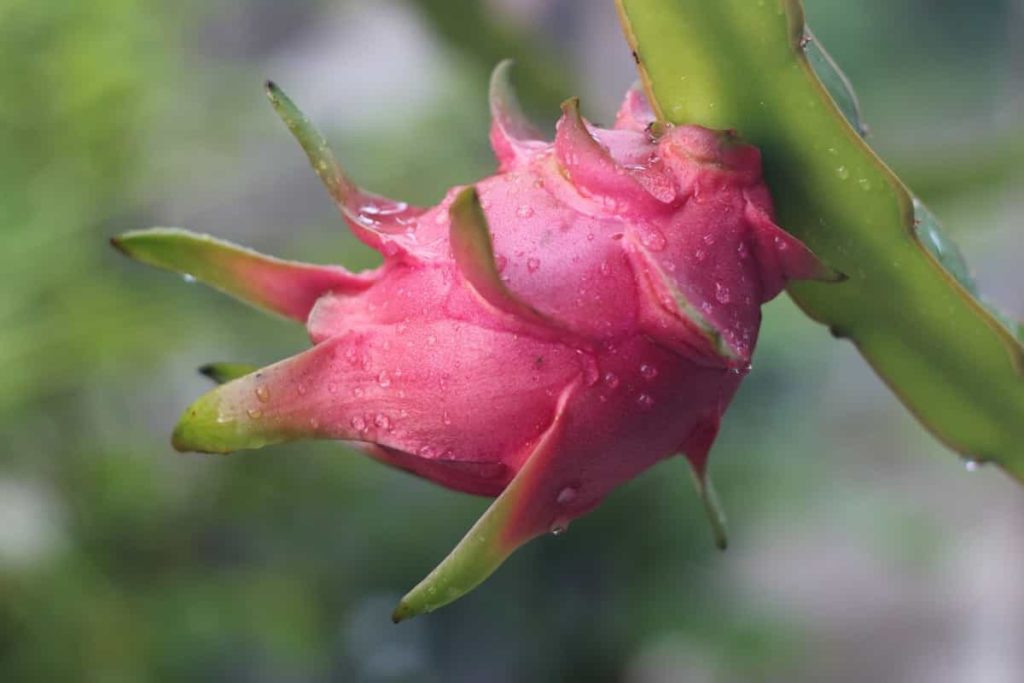
The approximate weight of dragon fruit is between 150 and 600 grams, while some can get up to 1 kg. The fruit’s seeds can be saved for later use if they are separated from the pulp and cleaned thoroughly before drying. Ideally, fruit would be both spotless and overripe. Even as an indoor potted plant, seeds flourish in a soil mixture made of compost or potting soil.
After 11–14 days of shallow planting, pitaya cactus typically sprouts. The risk of overwatering is significant for cactus plants grown in the house. These plants will eventually find something to climb on, and when they do so, they may develop basal and aerial roots as they move upward through the branches. The plant is ready to bloom when its weight reaches approximately 4.5 kilos. Between 1,100 and 1,350 plants per hectare are the optimal density for commercial plantings.
It may take plants as long as 60 months (or 260 weeks) to reach full commercial production, at which point 20–30 metric tons per hectare can be harvested. It’s not uncommon for dragon fruit flowers to open at night and then wilt by the next day. It is because they can only get fertilized by nighttime insects like bats and moths. Cross-pollinating with a second, genetically distinct plant of the same species normally boosts fruit set and quality, while self-fertilization may be successful in some species.
Several “self-fertile” cultivars have been developed by selective breeding. Because of this, home growers won’t be able to make as much fruit. However, depending on the environment, the plants might produce blossoms three to six times annually like other cacti, healthy stem fragments which can sometimes be planted in soil and grow into a new plant.
How to start Dragon fruit farming/Pitaya in Thailand
Top Dragon fruit production regions in Thailand
After Vietnam, Thailand is Southeast Asia’s second-largest dragon fruit producer. Dragon fruit thrives under the weather conditions found in Thailand’s northeastern region. As a result, it is the most productive area in the country. Loei in the Northeastern area, Samut Sakhon in the Central region, Nakhon Ratchasima in the Northeastern region, Ubon Ratchathani in the Northeastern region, and Sakhon Nakhon in the Northeastern region are some of the top dragon fruits producing regions in Thailand.
In case you missed it: A Guide to Regenerative Agriculture: What is Regenerative Agriculture?, How to Start from Scratch
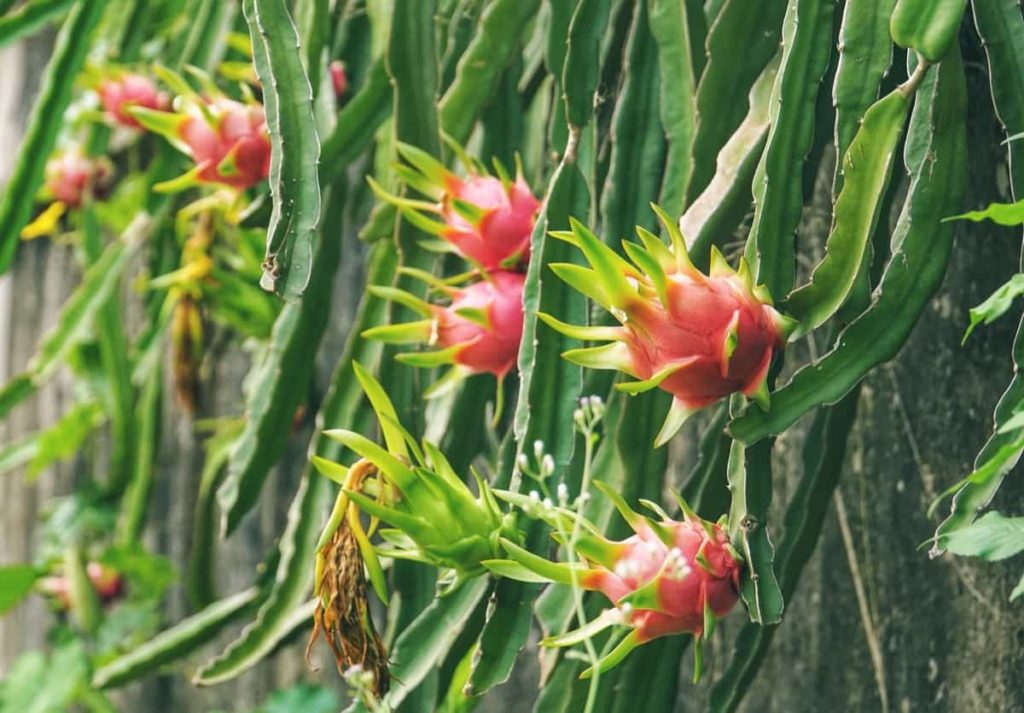
The Dan Sai and Phu Ruea Districts of Loei Province are well-known for producing delicious dragon fruits, making them popular with customers and retailers. The Phu Ruea dragon fruit has recently gained widespread popularity. Dragon fruits in Loei come in three different kinds. The red peel and white flesh variety account for more than 95% of annual production.
Red peel with red flesh varieties makes up hardly more than 4% of the annual production. The dragon fruit with a red peel and red flesh is in high demand and can currently be exported to most countries. Fewer than 1% of the population prefers a yellow peel with white flesh. Therefore that variant is making its way into production.
Best season to cultivate the Dragon Fruit in Thailand
Depending on the year’s season, Thailand is either an exporter or importer of dragon fruit because it is one of the few tropical countries that can grow the fruit. In Thailand, the months of April through October are ideal for harvesting dragon fruit due to the fruit’s naturally occurring growing season. On the other hand, a smaller harvest and fewer imports are possible during the off-season months of November through March. The central plains and the northeastern uplands of Thailand are the primary production areas.
Obstacles to year-round harvesting include an abundance of fruit in June and July, when demand is lowest, and the fact that only irrigated areas can sustainably produce during the off-season. In addition, off-season flowering initiation by artificial light sources is effective but is constrained by the considerable energy required to power such systems. Using CPPU to increase blooming at off-seasonal times saves time and money. Although this technique can be used to force blooming, it relies on the grower’s expertise to select the optimal buds.
The majority of harvests are sold and consumed domestically. Some that meet export standards can be shipped abroad. Although dragon fruit plants can withstand temperatures as high as 40 degrees Celsius and brief frost episodes, they cannot withstand prolonged subfreezing conditions. The dragon fruit plant may thrive in dry, tropical regions with moderate annual rainfall. It is considered an invasive weed in several places since it has escaped cultivation and become a weed in many regions.
Varieties of Dragon fruit in Thailand
Thai Dragon
The Thai Dragon is a Dragon Fruit that comes from the white flesh species of the genus Hylocereus. The Thai Red Dragon Fruit is a delicious and exotic variety of Dragon Fruit that may be found in Thailand, hence the name. It grows quickly and is self-fertile this is a great option if you’re just getting into producing Dragon Fruon.
Thai Dragon is a self-fertile variety with flowers that are typical of white flesh species. They bloom in abundance for two or three seasons each year, usually beginning in June. Flowers take about 21 days from bud opening to full bloom. These exquisite flowers only open up at night.
Alice Dragon Fruit
This variety is Named after California Rare Fruit Growers Association member Alice Snow. The average weight for this medium-sized fruit is between 0.5 and 1.0 pounds, and it has a semisweet flavor. When fully ripe, the fruit’s outer skin turns a brilliant hot pink, making it one of the most visually impressive varieties. However, cross-pollination is necessary for this variety to bear fruit.
David Bowie
David Bowie is a leaner white variety with a slightly lemony, sweet, and tangy flavor. The fruit weighs up to a pound and can be between medium and large. Though fresh consumption of the fruit is recommended, this can also be used for juicing or as a garnish. Since this type is capable of self-pollination, no cross-pollinator is needed to produce fruit.
Natural Mystic
Introduced to Florida from Thailand, this variety is being commercially grown in Homestead on a small scale. It regularly yields dark reddish-purple fleshed fruits that typically weigh up to one pound. It could be grown without the need for either cross or hand pollination, making this a fantastic option for garden farmers and commercial operations.
Makisupa
The flesh of the Makisupa, a deep pink color, is sweet and slightly acidic. The fruit’s pink exterior is enhanced with short, green fins that are artfully twisted around the fruit. They can get up to a pound in size and can pollinate themselves.
Soil preparation procedure in Dragon fruit production
The dragon fruit plant is adaptable and may grow in various soil conditions. Planting is done mostly in the Central Plains near Bangkok and in the highlands of Phu Ruea District in Loei Province, which has a slightly distinct planting strategy due to its topography. While the dragon fruit is typically grown in the ditch system in low-lying places, it is instead planted on flat soil in the uplands of the upper northeast regions. The only reliable source of water for this type of farming is rainfall.
In case you missed it: Oklahoma Vegetable Planting Calendar (OK): Month Wise for Fall, Spring, Summer, Winter, Zone 6, Zone 7, and Zone 8
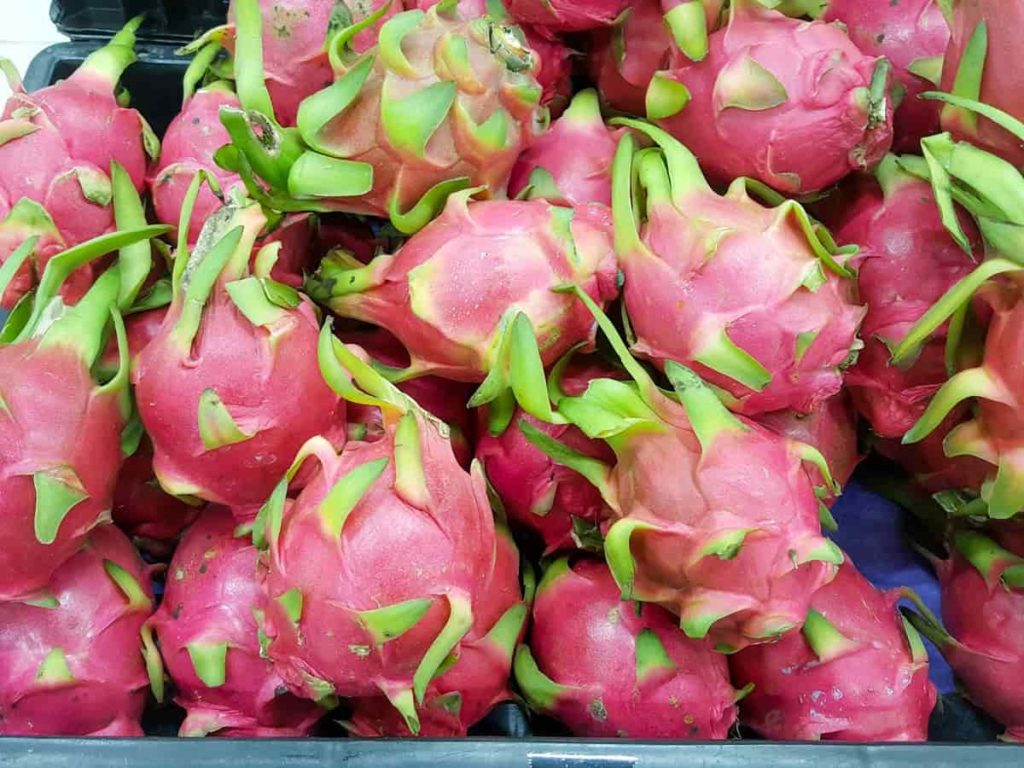
However, since most farms don’t have access to an irrigation system, fruit quality is low, and off-season harvesting is impossible. The stem of the dragon fruit plant lengthens as it climbs up the cement pole, giving the plant a vertical appearance. The distance between the poles is around 3 to 3.5 meters. The pole is around 1.5 meters above ground and 0.5 meters deep into the ground. Depending on readily available material, this pole can be either a 2-3″ concrete pole or a 4-6″ hollow sewage cement pipe.
A small platform is mounted on the top of the pole to hold up the heavy dragon fruit stem. Such a platform is typically constructed from cement or iron bars wrapped in an old bicycle tire. Three to four stem cuttings are planted vertically near the pole’s base. When given enough time, the plant will eventually reach the very top. When it comes to soil conditions, the dragon fruit plant does not like wet soil and can survive dry spells.
However, adequate water is essential to acquire both quantity and quality of the yield during flower and fruit development. Flowers and fruits are more likely to drop during drought, but root rot is more likely to occur during this period. Therefore, soil type and drainage are two factors that need to be considered when planning to care for planting beds during the wet season. Sandy loam is preferred because of its high water-holding capacity and excellent aeration. Soil pH should be between 6.3 and 7.8.
Pruning of Dragon fruit plants
Take some time to trim the dragon fruit tree. Some dragon fruit plants can grow to be as tall as 20 feet. If it grows too big, you should trim it by removing branches. A lighter load may help it grow stronger, concentrate nutrients, and blossom. In addition, the branches may be reused instead of discarded. The branches can easily take root in new soil, so you can either plant them and grow another dragon fruit plant or give them away.
Irrigation and water management in Dragon fruit farming
Dragon fruit requires the same watering care as a tropical cactus. You should only water it lightly when it is completely dry. Keep the climbing pole wet if your plant has grown big enough to need one. For this purpose, a dripper would be ideal. A common cause of death for dragon fruit plants is being overwatered. Remember to consider how well the soil drains. Even less water is required if there are no drain holes, as that would merely cause the water to pool at the base, encouraging mold and mildew.
The only water source for dragon fruit crops in the highland area of Loei Province is the rain that falls between April and October. As a result, the vast majority of harvests come from untended flowering. The dry months of November through March mean fruit cannot be harvested out of season.
Drip irrigation is used in only a small number of farmlands, although it can significantly improve fruit quality. However, central plains farmlands have reliable access to water resources year-round, including the dry months of November through March. Thus, with the right technology and low enough prices, this region should be able to grow fruits out of season.
Fertilizer management in Dragon fruit farming
The NPK ratio of the fertilizer you select is crucial. The NPK ratio of a fertilizer is the percentages of nitrogen, phosphate, and potash in that fertilizer expressed as a set of three hyphenated integers. For a fertilizer to be considered “balanced,” all three of these numbers must be the same, as in the case of 10-10-10. In terms of fertilizer, there is no universally accepted advice. However, most professionals agree that a balanced fertilizer, like 16-16-16 or 13-13-13, is the best option for your dragon fruit.
Fertilizers can be used as granules or dripped onto the ground using an irrigation system. Plants between the ages of one and three should be fertilized every two months. You should fertilize your plant with chemical fertilizers and organic materials like dung or compost. Ferrous sulfate or chelated iron should be applied four to six times between March and September. Traditional fertilizer should be used three to four times yearly for mature plants.
Reduce how often you apply manure or compost to twice a year. Fertilize your plants four to six times yearly with chelated iron or ferrous sulfate between March and September. A new plant requires 0.25 pounds (118 g) of fertilizer and 4 pounds (1.2 kg) of manure. Even when they’re just starting, dragon fruit trees don’t require a lot of fertilizer or manure. A quarter pound (118 g) of fertilizer and four pounds (1.2 kg) of manure or compost is required for every fruit plant.
You should feed your plant with more manure and fertilizer as it develops. Add 0.3-0.4 pounds of fertilizer when the plant reaches the age of 2 years. Apply 6 pounds (2.7 kg) of manure or compost to each dragon fruit plant during this period. Regular applications of 0.5 to 0.75 pounds of fertilizer and 5 pounds (2.2 kg) of manure should begin when your dragon fruit tree is at least four years old.
Pest and disease management in Dragon fruit farming
Anthracnose
In Thailand, Anthracnose is the most frequent and harmful disease of dragon fruit. It’s a big issue before and after harvest for dragon fruit farms. Infected stems and fruit displayed reddish brown spots surrounded by a yellow ring is a symptom of Anthracnose. A ring of reddish-brown spots will develop near the vine’s ribs, specifically where the spines erupted from the rib edge. When plants are damaged, the quantity and quality of fruit produced are affected. During wetter months, this condition is more common.
Fruit Rot
The first signs of this rot appear as tiny, round spots of a tan color on the surface of the fruit. And as the disease continues, the spots become larger and eventually turn black. Fungus development on spots typically appears as a black substance. Large patches of soft rot form on the fruit in warm, humid weather. The symptoms included soft rot on fruit and flowers caused by depressed water-soaks lesions surrounded by olive-to-black powdery spots. Flowers were another target of the disease’s damage. Black, hairy colonies of the pathogens grow on the fruit.
In case you missed it: How to Start Sweet Potato Farming in Asia: A Guide of Cultivation for Beginners

Stem Canker
This virus is responsible for the most significant infection of dragon fruit, which manifests as a canker or spot on the stem or fruit. It caused major damage to dragon fruit cultivation in Thailand. The disease grew on tender new shoots and fruit in warm, damp conditions. Several tiny, spherical, reddish-brown patches develop on the infected stems. These patches keep growing and eventually cover extensive canker areas on the stems. Tissues become yellow, soften, and eventually rot off, releasing an unpleasant odor.
After producing black pycnidia fruit, the stem eventually gets withered. Several ideas and strategies are used for effective plant disease management, regardless of the species or growing conditions. It includes avoiding, excluding, and eliminating the sources of the problem. The most effective disease control method is removing diseased plants through total destruction or severe pruning. Also, another best idea for disease management is, after harvesting and pruning, to spray copper fungicide to prevent bacterial and fungal infections.
Harvesting process of Dragon fruit
You should harvest the fruit in the latter half of the year. If given enough water and temperature, dragon fruit can fruit practically year-round. However, prime harvest times are late summer and fall. When the skin of a dragon fruit turns red or yellow, depending on the variety, you know it’s ready to harvest.
When gently squeezed, the skin will have a soft but not mushy texture. Dragon fruits are ready to be picked when the color of their peel changes from green to red, dark crimson, or purple red with vivid green branchlets. The optimal time to pick fruit is between 35 and 40 days after flowering. The flavor of fruits is ruined if they are picked too soon.
However, they become overripe and translucent if they are picked when they are past their optimum. The fruit is best harvested first thing in the morning before the day’s heat sets in, trimmed with a curved trimmer at the stem’s base, and handled gently to avoid damage during sorting and packing. If the stems of the fruit look dry, don’t harvest the fruit.
If the stem of your dragon fruit is dry, it may be past its prime. Determine if the fruit is rotten by touching the stem to see if it is dry and brittle. Once a dragon fruit is ready to be picked, it can be readily detached from the plant by twisting it off a few times. Too much resistance while pulling on the fruit indicates it is not yet ripe for harvesting.
How much yield can you expect from a Dragon fruit crop?
Dragon fruit trees in Thailand typically produce 30 fruits in the first year, 50 fruits in the second year, 100-200 fruits in the third year, and 300 fruits or more per tree in the fourth year onwards. Depending on maintenance, each individual fruit might weigh anywhere from 200 to 700 grams. Economic fruit yields often begin in well-managed orchards after three years, with an average yield of up to five tons per acre. The predicted yield per hectare can range from 10 to 30 tons per hectare, depending on the environment and method adopted.
In case you missed it: How to Start Gardening at Home for Beginners: A Full Planting Guide for Flowers, Fruits, Herbs, and Vegetables
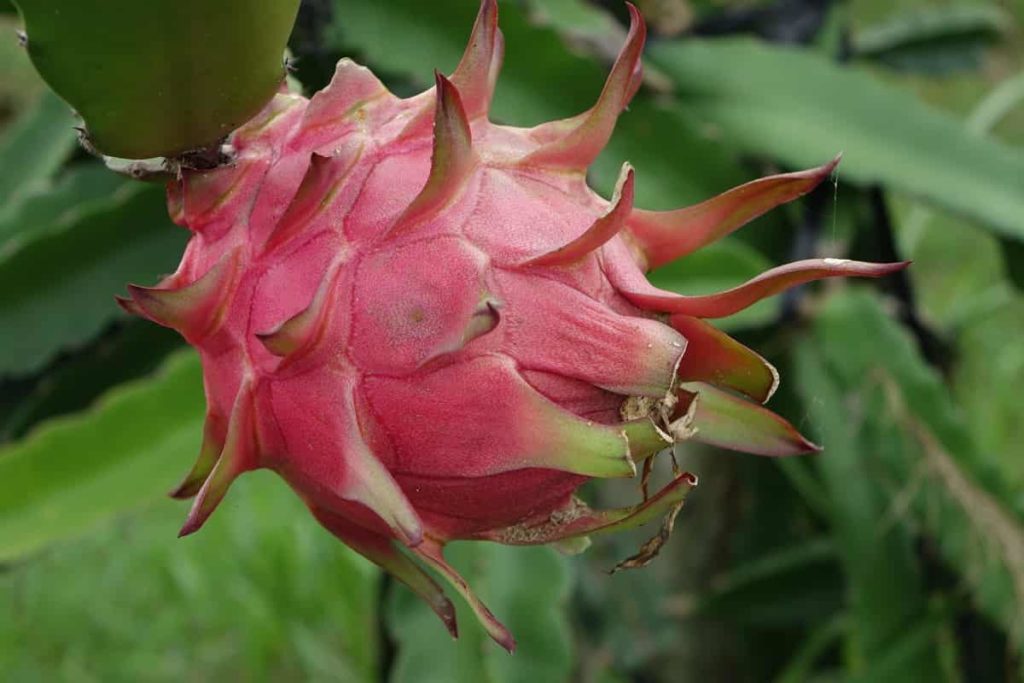
The growth period of Dragon fruit
Six to eight months is all it takes for a plant to start flowering, yet it could take up to two years for a plant cultivated in a container to produce fruit. The good thing is that a mature plant can continue producing fruit for 20-30 years. Each year, the plant may go through four to six fruiting cycles.
Additional lighting requirement in Dragon fruit cultivation
The dragon fruit plant responds well to supplemental lighting at night, which can be used to mimic extended day conditions or night breaks. Simply plug in a 100-watt incandescent light bulb, place it above the canopy, and align it with the rows of plants to achieve this effect. The lights are turned on for increasing duration of time. Turning on the lights for 10 hours a day for 18 days in the months of November and December can stimulate the growth of flower buds.
The longer the time frame, say 30 days, the less light is needed, such as 3 hours per day. However, this method may result in a low yield of flowers compared to the first. Off-season flower induction requires sufficient light intensity, light quality, light duration, and the number of lighting days.
Unfortunately, the high cost of electricity means that this technique is not significant in Thailand. Unhealthy plants that are exposed to light have fewer or no blossoms developed. Storing photosynthate in the stems is crucial for producing fruit out of season. It is also possible to drastically save costs by switching to energy-efficient lighting (LEDs) or using light of a certain wavelength.
In case you missed it: Top 31 Vegetable Garden Ideas at Home: Check How this Guide Helps Beginners
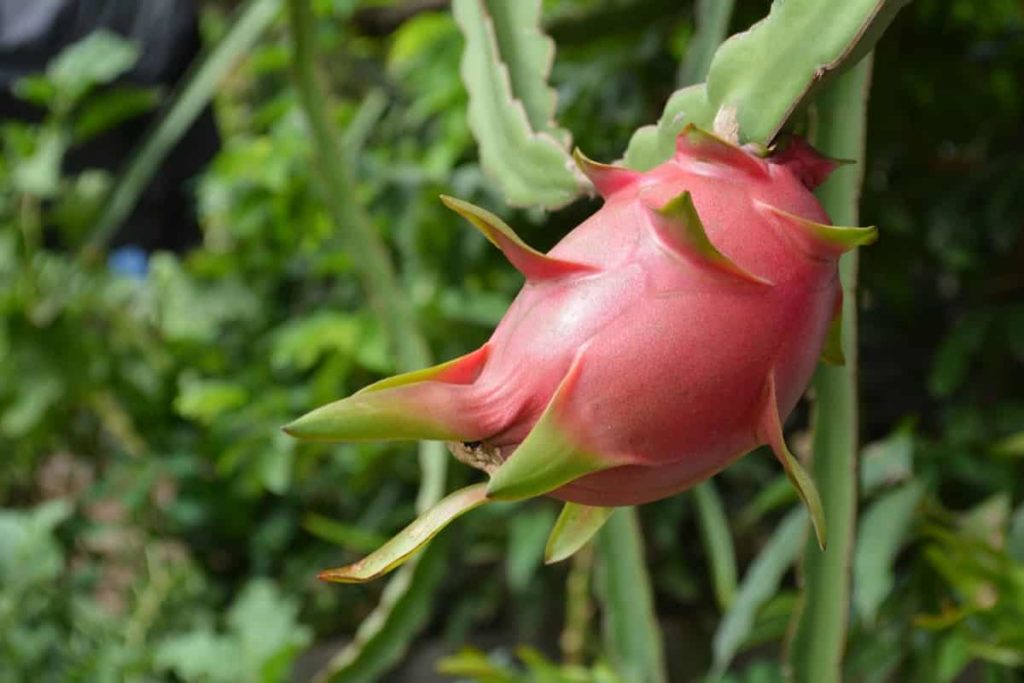
Conclusion
Because of favorable climatic conditions, great production, high demand, and profitable returns, dragon fruit cultivation in Thailand have expanded quickly in recent years. The climate requirements for the plant’s successful establishment span from the northern to the southern reaches of the country and from 100 to 800 meters above sea level. The plant’s many benefits include producing fruit from cuttings with minimal care and as early as a year old.
It can be harvested multiple times yearly, with high yields of up to 16 times yearly to nearly all year round. Its ability to maintain its high yields for more than 20 years. Its high profitability and net return. And its good functional properties and uniqueness, particularly its health benefits due to its high level of antioxidants. More farmers are drawn to dragon fruit growing because of the first three features. The latter two allow for export to more developed nations and motivate farmers to raise product quality to suit market expectations.
- Management Pests and Diseases in Your Cotton Field
- Sheep Farming Business Plan for Beginners
- Aquaponic Farming at Home: A Step-By-Step Guide
- Profitable Village Farming Business Ideas in 2024
- High-Yield Aquaculture: Fast-Growing Fish for Farming
- Effective Fish Pond Construction Techniques for Beginners
- Irrigation and Water Management in Pineapple Farming
- Blossom to Harvest: Mastering Flowering and Pollination in Papaya Farming
- Pig Fattening Essentials: From Selection to Sale for Beginners
- Raising Wagyu Cattle: A Complete Guide for Premium Beef Production
- Soil Types and Their Water Holding Capacity
- Optimizing Irrigation Schedules for Coconut Groves for Enhanced Yield
- Espresso Your Garden: Coffee Grounds for Healthier Acid-Loving Plants
- The Best Soil Mix for Snake Plants: How to Mix Your Own Snake Plant Soil
- Green Thumb Success: Expert Tips for Cultivating Greenhouse Beans All Year Round
- Bloom All Year Round: The Ultimate Guide to Indoor Hyacinth Care
- Eco-Friendly Gardening: How to Make Liquid Fertilizer from Kitchen Waste
- Ultimate Guide to Grow Anise in Pots: Explore Seed Propagation to Harvesting
- Guide to Raising Chester White Pigs: Discover Breed Facts to Growth Management
- Mastering the Elegance: The Ultimate Guide to Weeping Cherry Tree Care, Planting, and Maintenance
- Ultimate Guide to Planting Garlic in Grow Bags: Growing Strategies for Beginners
- How to Fix Spider Plant Leaf-Related Problems: Natural and Organic Remedies
- 10 Reasons Why Your Tulsi Plant is Shedding Leaves: Home Remedies and Solutions
- Optimizing Growth and Yield: The Advantages of Palm Bunch Ash Fertilizer
- Utilizing Neem Oil Extract as a Natural Pesticide for Hydrangea
- From Soil to Harvest: Various Ways in Which Farmers Can Use AI Tools
- Steps to Encourage and Induce Citrus Flowers: A Comprehensive Guide
- How to Fix Snake Plant Leaf-Related Issues: Natural and Organic Remedies
- Transform Your Garden into a Fragrant Oasis with Raat Ki Rani (Night Blooming Jasmine)
- Discover the Ideal Chicken Breeds for Philippine Farms
- How to Create a Poultry Egg Farm Business Plan for Profits
- Grow Lemon Cucumbers Like a Pro: Insider Techniques for Bountiful Yields
- Ultimate Guide to Caring for Your Pink Princess Philodendron: Tips for Thriving Variegation
- Areca Nut Profit Per Acre: Calculating Yield and Cost of Cultivation
- How Kaveri Chicken is Becoming a More Profitable Breed in Indian Backyards
- Transform Your Barn: 9 Steps to Convert a Horse Stall into a Chicken Coop
